Writing the Climax: The Story Structure Series Part Eight
If storytelling is a game of chess, this is checkmate…
Or more specifically, the Climactic Moment is. Here, both sides of your story’s conflict will confront each other one final time. This is the last hurrah of your story, and it’s here that you’ll fulfill the promises you made to your readers from the beginning, giving them an intense and dramatic conclusion to the journey you’ve just taken them on.
Of course, the Climax is more complicated than it may seem at first glance. Not only does it wrap up the threads of your story, but it also contains an entirely distinct plot point within it, and one you don’t want to ignore—the Climactic Moment. So, what’s the difference between these two plot points, and how can they work together in your story?
_______________________________
This article is part of a series of posts about the Three Act Structure. If you’d like to check out the rest of the series, make sure to browse the other articles listed at the end of this post.
_______________________________
The Role of the Climax
Contents
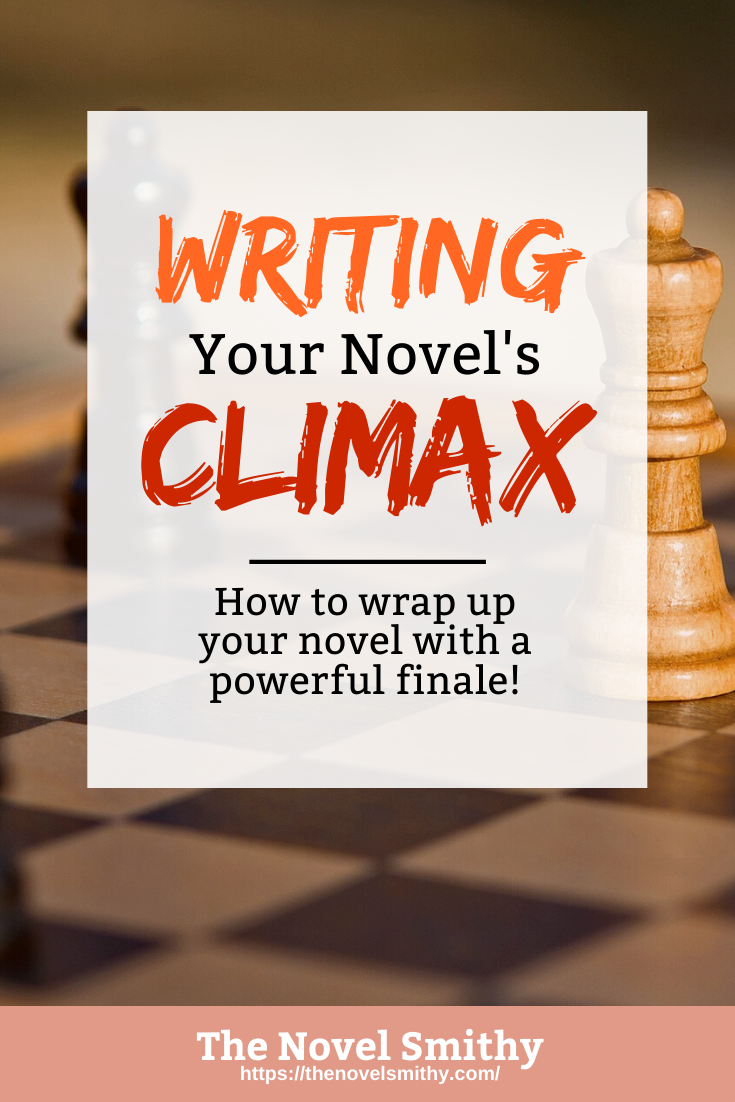 In simple terms, the Climax is the start of your protagonist’s final confrontation with your antagonist. They’ve overcome their low point after the Third Plot Point and reentered the conflict prepared to fight to the end. Your reader is tense and primed to see this story to its conclusion.
In simple terms, the Climax is the start of your protagonist’s final confrontation with your antagonist. They’ve overcome their low point after the Third Plot Point and reentered the conflict prepared to fight to the end. Your reader is tense and primed to see this story to its conclusion.
It’s time to deliver on all your promises!
Based on this, it’s easy to see that the Climax fulfills a lot of roles within your story and the Three Act Structure, from concluding your plot to wrapping up your character arcs. You’ve been building up towards this moment since all the way back at your Hook, so you don’t want to disappoint your readers now.
So, to help you unpack the Climax fully let’s review each of it’s roles, starting with your plot.
Your Plot:
To start, the Climax is a point of no return for your protagonist.
Much like the First Plot Point was a point of no return for the start of their journey, the Climax is a point of no return for its end. Once your characters enter the Climax, the conflict of your story will reach a conclusion—whether or not it’s in their favor. You’ve backed them into a corner, trapped them, and now they’re forced to fight back.
Ideally, their decision to reengage with the conflict after the Third Plot Point will be what locks them into the fight ahead. This is the case for one primary reason. You see, it makes their ultimate confrontation with the antagonist their choice, a result of their own conscious, morality, or decisions.
It gives the Climax meaning on a level that goes beyond coincidence or bad luck.
For example, a meaningful Climax needs more storytelling impact than your character bumping into an old friend at the grocery store. Instead, they call that friend of their own accord and apologize for years of misunderstanding and conflict. The first situation is by no fault of their own—they didn’t earn it. The second is meaningful because they actively sought it out.
Your Characters:
Similarly, tying the Climax to an active choice by your protagonist helps it fulfill its secondary role as the culmination of their character arc.
Within a character’s arc, the Climax is the final stage of that character’s growth. Here, your protagonist will have to confront their truth and address their need. This is in large part because of how the Third Plot Point and the Climax traps them—they have little choice but to confront these difficult issues.
Essentially, the Climax’s job is to force your protagonist to act on their truth, building and building until they overcome their inner struggle at the Climactic Moment—which we’ll look at in a few seconds.
The Conclusion of Your Story:
The last major role of the Climax comes in ending your story. However, its placement isn’t exactly “the end.” Instead, your story will end with the Resolution, which directly follows the Climactic Moment.
So where exactly does the Climax fall?
Well, this depends on what final plot threads and subplots need tidying up after your Third Plot Point. It’s important to remember that the Resolution is only a single scene—maybe two—meant only to clean up any last story bits and leave your readers with closure.
If the Resolution drags on through multiple scenes, subplots, and cast members, it will often suck the energy out of the ending of your novel. This means that, as much as possible, you need to get these subplots and minor issues resolved or near resolved before the Climax, so you can lightly touch upon them in the Resolution, instead of eating up the time needed for your protagonist’s final moments.
With that in mind, for the majority of stories, the Climax should take up most of Act 3.
As the pace picks up after the Third Plot Point, the major players within your story are on a fast march towards one another—once your protagonist has had time to reflect and rededicate themselves to overcoming the conflict, there isn’t much reason to linger. Get your players into place for the final confrontation, and let the battle begin!
Where Does the Climactic Moment Fit In?
The Climax Versus the Climactic Moment:
The Climactic Moment is an interesting plot point because, instead of being standalone, it’s nested inside the Climax. It’s the decisive moment that resolves the conflict between your protagonist and antagonist, the moment the Climax has been setting up all along. Essentially, it’s the moment you answer your Dramatic Question from all the way back in Act 1.
Will they live happily ever after? Will they defeat the dark side, or prove that dragons can live alongside humans, or save China?
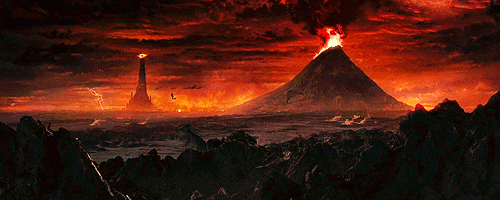
Say your Climax was the typical final battle of a fantasy epic. The two opposing armies would go crashing into one another to decide the fate of the world. Yet, this isn’t the Climactic Moment. That wouldn’t come until late-battle, when all seems lost before your protagonist hunts down the antagonist on the field, facing off one on one to decide their fates.
Do you see the difference?
The Climactic Moment is the deciding event of your novel’s conflict, while the Climax is more about setting the stage. Here your protagonist’s growth will determine if they succeed or fail in a true final test. It begins the transition from conflict to resolution, ends your hero’s arc, and concludes “the journey.”
As a result, this is the time to drive your story to its logical conclusion and show just how far your characters have come! No need to be melodramatic, but don’t be afraid to push the envelope—so long as it resonates with your broader story and plays on themes and symbols you’ve previously introduced, you’ll be just fine.
The Climactic Moment and Your Protagonist:
In the same vein, the Climactic Moment is the logical conclusion of your protagonist’s arc. In this moment, the decision they make—either to put their truth into action or abandon it—will determine if they succeed, both in the plot and in their character arc.
This final moment of growth can manifest in a variety of ways.
It may be a dramatic speech, a quiet and meaningful internal realization, or a spur-of-the-moment choice they never could have made before. Whatever it is, they must prove they’ve embraced their truth and overcome their inner struggle through the actions they take in the Climactic Moment. Without action, their journey will feel hollow.
“Actions speak louder than words.” – Abraham Lincoln
Two Separate Plot Points:
So, why is it wise to separate the Climax and the Climactic Moment in your mind? Does it really matter that much?
At the end of the day that’s for you to decide. But here’s my case…
The Climax is the setup for the Climactic Moment. It gives your other characters time to play their part and complete their own arcs, while setting the stage for your protagonist’s moment of truth. By separating the two plot points in your mind you give yourself a goalpost to write towards during the Climax.
You see, it’s easy to have so much fun with a scene—especially one as dramatic and eventful as the Climax—that you lose sight of where your story needs to end up. By remembering, “Oh, I’m still missing my Climactic Moment,” you ensure that you end your story with a bang, giving your readers the full impact you promised them.
Instead of staying in “setup” mode forever, you actually reach the finale!
That’s what the Climactic Moment is. It’s the end of the conflict and therefore comes at the very last moment of your Climax. From here, you get to shift to your Resolution, as your characters figure out what this new victory—or failure—will mean for their lives.
The Climax at Work
Disney’s Mulan:
Beginning the Climax:
When we last checked on Mulan, she had just confronted her inner struggle and realized the Huns were still alive. Knowing she couldn’t leave her friends in danger, she set out to the Imperial City. Her Climax begins upon her arrival. Here she confronts Shang along with other civilians, but no one listens. She’s a woman now, and this scene reminds her of exactly what that means in her society.
Before this point she probably would’ve backed down, but now she persists.
Through this her character growth begins to show in tangible ways, and this only gets stronger as the scene progresses.
Soon the Huns reveal themselves and capture the Emperor, barricading him in the Imperial Palace. Mulan calls on the respect she gained as Ping to convince the other soldiers to trust her. Using her cleverness, she devises a plan to break into the palace and trick the Huns. Even better, she does so using skills she learned throughout Act 2. This makes the scene resonate with the rest of her adventure and feel like a true result of her growth as a person.
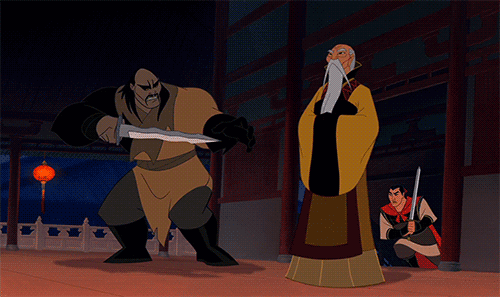
Of course, not only does this scene show tremendous growth for Mulan, but it also shows Shang overcome his own arc. Just like the rest of her friends, Shang learns to trust her in this scene. He begins to respect her for who she is, rather than judging her for her gender or insisting on his own dominance.
So, with Shang and friends now in tow, Mulan sneaks into the Imperial Palace, ultimately confronting the leader of the Huns. In a tense sword fight he disarms Shang, thinking he caused the avalanche that wiped out the Hun army—but we know better.
This is where Mulan’s Climactic Moment begins.
The Climactic Moment:
Mulan reveals that she was the one who triggered the avalanche, pulling her hair back to mimic the male hairstyle she wore as a soldier. She’s confident in who she is and acts on that confidence. This draws the Hun leader’s attention to her, shows her overcoming her inner struggle, and saves Shang’s life.
From here, her task is to protect her friends and end the conflict.
This scene draws a great contrast between Mulan and the Huns here, one the movie has been building up to from the very first scene. Mulan’s cleverness and intelligence conflicts with the raw rage of the Hun leader. It would be impossible for her to match him in a physical confrontation, but in relying on her brains, she can still succeed.
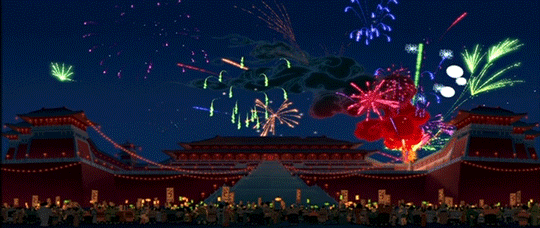
As you might remember, themes of “brains versus brawn” or “masculine versus feminine” have been highlighted throughout this movie. Not only that, but it’s a core part of Mulan’s inner struggle. Though her traditionally “feminine” traits have been treated as a weakness, Mulan now proves once and for all that they’re her strongest asset, making the movie’s theme resonate even more clearly.
Ultimately, Mulan and Mushu trick the Hun leader onto the roof of the Imperial Palace. Here they use their opportunity to launch a firework that kills him, ending the conflict and allowing Mulan to escape safely.
The Dramatic Question:
Bam! Done, right? This is a nice flashy action scene where Mulan defeats the big baddie. The movie’s Climactic Moment is over and it has answered its Dramatic Question—right? Well, if you remember from all the way back in part three of this series, Mulan’s Dramatic Question is:
“Will Mulan survive the war and return to her family with pride?”
We’ve only answered half of that question at this point—the rest won’t come until the Resolution. This isn’t that unusual either. Often, some aspect of the Dramatic Question will be left for the Resolution, because it directly involves your protagonist’s journey home after the conflict is over, much like Mulan’s. So long as at least part of the Dramatic Question is resolved by your Climactic Moment, this really isn’t a problem.
Nausicaä of the Valley of the Wind:
Beginning the Climax:
Much like Mulan’s rush to the Imperial City, Nausicaä’s Climax begins when she escapes the Pejite airship and races towards the Valley.
En route she spots the stampede of Ohm below her, and soon she finds the baby Ohm the Pejite soldiers are using to bait the herd. As she gets closer, she sees that they have hooked it to a small airship, dragging its body behind them. Nausicaä circles until she ultimately crashes their ship onto an island in the Acid Lake, getting shot down as well in the process.
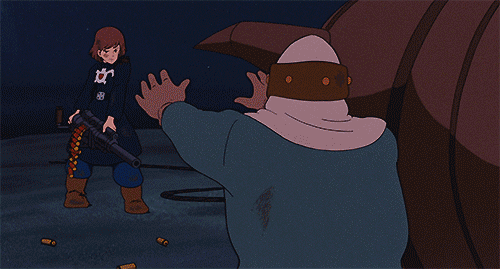
She desperately hopes that the herd will follow the baby and avoid the Valley, but as they approach the crash, the herd turns towards the Valley instead of venturing into the lake. In desperation, Nausicaä turns on the Pejite soldiers with their own machine gun, demanding they take both her and the baby Ohm to the herd.
What’s so wonderful about this Climax is how it directly challenges Nausicaä’s truth.
This scene pushes Nausicaä progressively harder and harder to prove her commitment to her truth—that humanity and nature can live in harmony, and that violence isn’t the answer. Using the baby Ohm as bait is such an incredibly cruel act, and it runs counter to all her beliefs. Not only that, her internal pain isn’t just implied, but shown.
As she grows more desperate, she grows more willing to use violence herself.
The Climactic Moment:
Now you may wonder why this bloodshed isn’t the Climactic Moment. The soldiers are clearly driving Nausicaä to her limit, forcing her to risk her own safety and her own morals.
However, the movie keeps upping the ante, pushing the story as far as it can.
The Climactic Moment begins as the Pejite soldiers drop Nausicaä and the baby Ohm in front of the approaching stampede. Behind her, Princess Kushana arrives with the Giant Warrior, ordering it to incinerate the Ohm, but its blasts are nothing against the rage of the herd. It collapses in a useless heap after just a few shots. All the major players in the movie are left to watch as their deaths approach—the Tolmekians, the villagers, and Nausicaä herself.
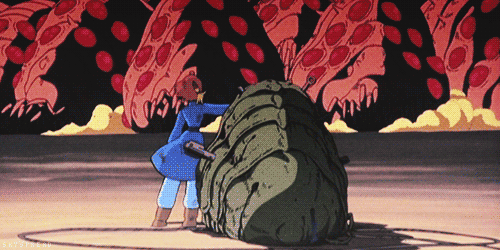
However, Nausicaä’s sacrifice—the embodiment of her total commitment to her truth—finally pays off. She allows the herd to trample her as a final act of faith, presumably being killed in the process, before the herd suddenly stop. With the baby Ohm standing next to Nausicaä’s body, the herd observes her and grows calm.
The scene ends with the Ohm resurrecting Nausicaä and healing her wounds, fulfilling the prophecy from the start of the movie and answering the Dramatic Question—a king will come garbed in blue, walking through a field of gold, to bring peace to the world. Awed by the prophecy come true, the Tolmekians retreat out of respect, and even Princess Kushana begins to accept that war might not be the answer.
Arcs, Themes, and Symbolism:
This marks the end of Nausicaä’s arc. Unlike Mulan, her goal wasn’t personal growth, but the growth of the world around her—and in fulfilling the prophecy and ending the war, Nausicaä has spread her truth and helped her world overcome its inner struggle.
Of course, there are certainly some issues with this scene.
The healing powers of the Ohm weren’t well established before the Climax, and some of the dialog from major characters is far too on the nose, draining some of the impact from Nausicaä’s resurrection.
However, it also does so much right. All the major players are in place—Princess Kushana, the villagers, Nausicaa’s grandmother, the Giant Warrior, the Ohm, and Nausicaä herself. The movie pushes the envelope to extreme levels, but never in a way that feels disconnected from the broader story, because it weaves in meaningful symbols and themes from Acts 1 and 2.
Ultimately, messiah heroes like Nausicaä exist on a fine line between storytelling and preaching. It’s hard to strike the right balance that both conveys the themes you want to, while also not forcing your point in readers faces. While this movie doesn’t handle that perfectly, it’s hard to deny how compelling this Climactic Moment is, even with its flaws.
Ending With a Bang!
With your Climactic Moment complete, you can finally wrap up the final scenes of your story. Your story’s conflict is resolved, your protagonist has hopefully grown and succeeded thanks to their journey, and it’s time to show what life will be like after the dust settles and everyone begins to heal.
So, next time we’ll take a deep dive into the Resolution and wrap up, not only with a breakdown of your story’s final plot point, but with a broader discussion of the Three Act Structure as a whole. Stay tuned! 🙂
Do you have any questions about the Climax? Let me know in the comments!
- ACT 1
- ACT 2
- ACT 3
- The Story Structure Series Pt.7: The Basics of Act 3
- The Story Structure Series Pt.8: Writing the Climax
- The Story Structure Series Pt.9: Perfecting the Resolution

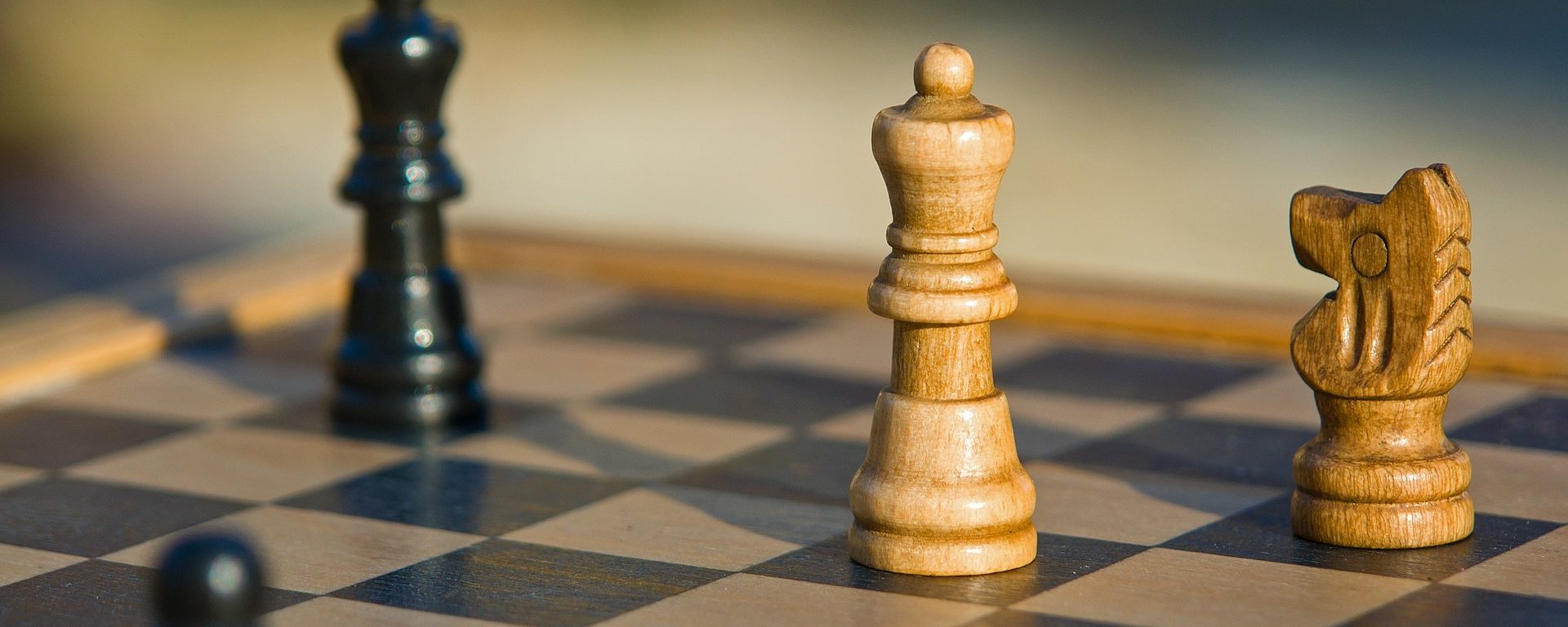

Leave a Reply